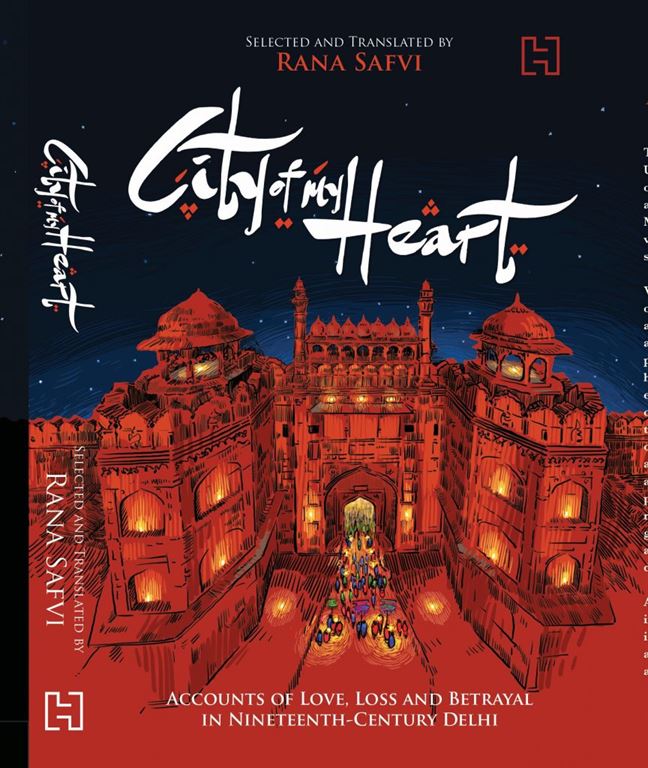City of my Heart
Accounts of Love, Loss and Betrayal in Nineteenth-Century Delhi
Translator: Rana Safvi (from Urdu)
Hachette India
247 pages; Rs 399
Early in Dilli ka Aakhri Deedar (translated as The Last Glimpse of Dilli), Syed Wazir Hasan Dehlvi writes: “Delli was never a city of just bricks and stones.” He adds that though the monuments of the city, such as Jama Masjid and the Red Fort, remained standing, its soul was dead. Written soon after the troubles of 1857-58, this narrative indulges in exquisite nostalgia for a lost city, its once-rich culture and society laid waste by the ravages of time. “Now, only a glimpse of that culture is to be found either in books, or on the lips of elders,” Dehlvi explains. “I want to hear these stories from them and laugh and weep with them.”
Readers will have enough opportunities to laugh and cry at the delectable recollections in the four short prose narratives included in this book. These are: 1. Dehlvi’s narrative I have mentioned earlier; 2. Bazm-e-Aakhir (The Last Assembly) by Munshi Faizuddin; 3. Qila-e-Mu’alla ki Jhalkiya’n (Glimpses of the Exalted Fort) by Arsh Taimuri; and 4. Begamat ke Aansu (Tears of the Begums), collected by Hasan Nizami. Ms Safvi is no stranger to the mid-19th century or the chequered history of this city. The books she has translated already include Dastan-e-Ghadar by Zahir Dehlvi (an eye-witness account of the 1857 war), and Asar-us-Sanadid, an account of the monuments of Delhi written by Sir Syed Ahmed Khan and published right before the troubles.
“Life in Delhi had an élan of its own and every day was a celebration,” she writes in the translator’s note at the beginning of the book. “The Emperor (Bahadur Shah) would participate in Hindu and Muslim festivals. There were literary and cultural soirées in the mansions of the noblemen, while dastangos sat on the steps of the Jama Masjid and enthralled audiences.” Explaining the reason for translating this book, Ms Safvi writes: “Almost every story or record of events in this volume has been written independent of the other. But each story corroborates and reinforces the common thread of syncretism that runs through its companions, indicating that it was the norm and not an exception.”
This claim is corroborated by all the narratives. “Hindus and Muslims lived as brothers,” writes Dehlvi. Faizuddin describes the life in the fort in great detail, listing Islamic festivals such as Eid, Ramzan, and the birth of the Prophet, as well as Hindu ones such as Saloni (Rakhi), Dusshera and Diwali, and Navroz, the Parsi new year. One of the most interesting festivals in the Mughal calendar, described in this volume is Phoolwaalo’n ki Sair, when the Mughal Emperor would leave the Red Fort and travel to Mehrauli across the city. (It has been revived recently and is held in November.) In the translator’s note at the beginning of the book, Ms Safvi writes: “The palace and the city had a syncretic culture — the Ganga-Jamuni — in which the quotidian life of the two different communities co-mingled and created an amalgam of …[a] pluralistic way of life.” In our undoubtedly divisive times, this is as much a political endeavour as a literary one, and there is much need for the wide circulation of such stories.
The four books are also populated with a list of interesting characters. Of course there is Bahadur Shah II, the emperor and his family, many of whom were killed by the British after the war, and others reduced to penury. One daughter of the exiled emperor, Gauhar Begum, became a beggar and then was hired as a cook at a household in the city; a son, Zafar Sultan, became a cart driver. There are numerous other characters as well — musicians Shah Nasir Wazir, Mirza Kale, Mirza Gauhar as well as calligraphers, Mir Panjakash Saiyyed Khush Navez Mohd Jaan Aga Saheb, Ahmed Jan, Imamuddin and Badruddin. “Who is Badruddin?” asks a listener to the story. The same one, replies the narrator, who was asked to the Queen of England to make a seal. We also meet Tanras Khan, the musician who established the Hindustani gharana.
The many different professions reflect the hurly-burly of a busy town. The descriptions of festivities and feasts, music and mushairahs, are, however, tinged with a note of sorrow. For a reader, the experience is that of travelling in a time machine or being pitch-forked into a different era, the colours of which are slowly fading. The characters in these books, lost in their mirth, their loves and their heartbreaks, are unaware of the fate that awaits them. The reader, however, does not have any such claims to innocence. All the four translated writers in this volume write that they hope to preserve a bit of the lost city. The pre-1857 Delhi might be an Atlantis lost in the ocean of obscurity and forgetfulness, but these narratives make it immortal. Ms Safvi performs the essential task of a translator — of finding a larger audience for these.
https://www.business-standard.com/article/beyond-business/lost-city-118110700003_1.html
Sent from my iPhone

